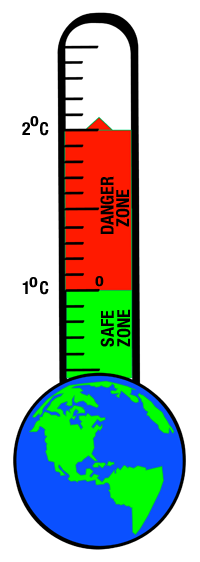CO2 – Why 450 ppm is Dangerous and 350 ppm is Safe

In my October 29, 2013, blog, Stranded Assets or Stranded Humanity. Choose One, I reviewed the math that supports leaving 80% of known fossil fuel reserves in the ground. That would allow us to limit the concentration of CO2 in the atmosphere to 450 ppm (parts per million) and have a 50:50 chance of limiting global warming to 2°C. Now scientists are telling us that this is a very dangerous and irresponsible strategy.
In September 2013, the Intergovernmental Panel on Climate Change (IPCC), the international body for assessing the science related to climate change, released its fifth assessment report. Authored by 250 climate scientists from 39 countries, it states: “It is extremely likely that human influence has been the dominant cause of observed warming since the mid-20th century.”The IPCC report goes on to describe the cumulative effect of our carbon dioxide (CO2) emissions.
“Emissions of CO2 from fossil fuel use and from the effects of land use change on plant and soil carbon are the primary sources of increased atmospheric CO2. Since 1750, it is estimated that about 2/3rds of anthropogenic [human] CO2 emissions have come from fossil fuel burning and about 1/3rd from land use change. About 45% of this CO2 has remained in the atmosphere, while about 30% has been taken up by the oceans and the remainder has been taken up by the terrestrial biosphere. About half of a CO2 pulse [emission] to the atmosphere is removed over a time scale of 30 years; a further 30% is removed within a few centuries; and the remaining 20% will typically stay in the atmosphere for many thousands of years.”
How urgent is the climate change issue? The urgency depends on how soon we will exceed what scientists deem to be a safe level of carbon dioxide in the atmosphere. Four levels of carbon dioxide concentrations in the atmosphere frame our choice.
- 280 ppm (Pre-indiustrial): The pre-industrial concentration of CO2 in the atmosphere in the 1750-1850 timeframe was about 280 ppm (parts per million).
- 400 ppm (Today): Between the start of the industrial revolution and May 2013, human activity increased the concentration of CO2 in the atmosphere to 400 ppm. These elevated carbon dioxide concentrations have already increased the average global temperature above pre-industrial levels by 0.85°C. As a result, we are experiencing severe weather events with wild extremes in temperature and precipitation. Climate scientists describe these anomalies as early signs of climate destabilization. Even if we stopped increasing CO2 levels now, the temperature would still rise other 0.8°C above the 0.85°C that we’ve already warmed, because of the cumulative effects described by the IPCC, above.
- 450 ppm (High risk): “The OECD Environmental Outlook to 2050: Key Findings on Climate Change” summarizes predictions by climate scientists’ models: we have a 50% chance of stabilizing the average global temperature at a 2°C increase over the pre-industrial period if we keep concentrations of CO2 under 450 ppm. A November 2013 report by PwC, Busting the carbon Budget, says that at our current rate of fossil fuel usage in the global economy, we will exceed that limit by 2034.
- 350 ppm (Safe): Many leading climate scientists do not have that appetite for risk. A December 2013 report by James Hansen, Johan Rockström, and 15 other scientists, “Assessing ‘Dangerous Climate Change’: Required Reduction of Carbon Emissions to Protect Young People, Future Generations and Nature,” declares that 2°C of global warming would have disastrous consequences and could cause major dislocations for civilization. (The bold highlighting is mine.)“Cumulative emissions of ~1000 gigatonnes of carbon (GtC), sometimes associated with 2°C global warming, would spur “slow” feedbacks and eventual warming of 3–4°C with disastrous consequences. … Rapid emissions reduction is required to restore Earth’s energy balance and avoid ocean heat uptake that would practically guarantee irreversible effects. Continuation of high fossil fuel emissions, given current knowledge of the consequences, would be an act of extraordinary witting intergenerational injustice.
“Witting”? If it were “unwitting,” it would be accidental. “Witting” means it would be deliberate and that we are fully aware of the dire consequences of our actions. It would be a march of folly.The authors advocate for a target of 350 ppm as the maximum safe concentration of CO2 concentration, which would stabilize the global temperature at 1°C above pre-industrial levels and avoid runaway climate destabilization.
That 350 ppm / 1°C limit gets my vote. But is it possible to reduce CO2 concentration to the 350 ppm level, given that concentration is already at 400 ppm? Yes. See my November 12, 2013, blog, A 12-Step Program for Our Fossil Fuel Dependency, for how.
The only thing missing is political leadership to make it happen. How long will we tolerate that witting abdication of responsibility? When threatened by terrorist bombings, countries declared a War on Terror. When threatened by rampant drug addiction, countries declared a War on Drugs. Climate change is biggest threat ever faced by humanity. Isn’t it time we declared a War on Climate Destabilization?
Please feel free to add your comments and questions using the Comment link below. For email subscribers, please click here to visit my site and provide feedback.
Bob




Comments are closed.